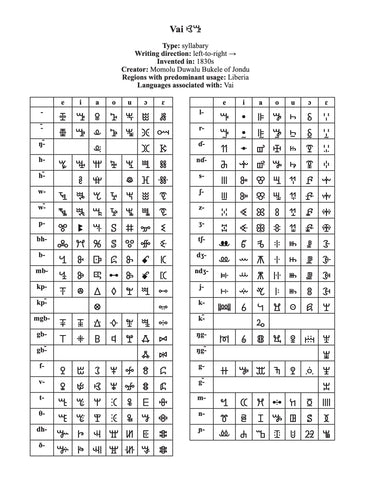Title: Vai Cuneiform: An Enigmatic Script of West Africa

Introduction: The Vai cuneiform is a unique and enigmatic script that originated in West Africa. Its distinct combination of cuneiform and syllabic elements makes it a fascinating subject for linguistic and historical exploration.
1. Script type: The Vai script is a syllabic writing system, where each symbol represents a combination of consonant and vowel sounds. It is noteworthy for its use of both cuneiform-like wedge-shaped characters and a more linear syllabic system.
2. Writing direction: The Vai cuneiform was traditionally written from left to right, much like modern writing systems.
3. Creator and invention time: The Vai script was created by a prominent figure in Liberian history named Momolu Duwalu Bukele, also known as Chief Kawalawu. It is believed to have been invented around the 1830s.
4. Time period of use: The Vai cuneiform has been used since its inception in the 19th century. While it faced challenges and periods of decline, it has experienced a recent resurgence as efforts to preserve and promote indigenous languages have gained momentum.
5. Population and current usage: The Vai script is primarily used by speakers of the Vai language, a Mande language spoken by the Vai people of Liberia, Sierra Leone, and Guinea. While it is not widely used beyond the Vai community, there have been efforts to teach and promote the script to younger generations.
6. Usage area: The Vai cuneiform has historically been used in the regions inhabited by the Vai people, mainly in Liberia, Sierra Leone, and Guinea. These countries form the heartland of the Vai-speaking community.
7. Languages associated: As mentioned earlier, the Vai cuneiform is used exclusively for writing the Vai language, which belongs to the Mande language family. Mande languages are widely spoken across West Africa and are known for their rich linguistic and cultural diversity.
Interesting Facts and Historical Significance:
-
Unique Script: The Vai cuneiform is remarkable for its distinct combination of cuneiform-like characters and syllabic elements. It stands out as a rare example of a cuneiform script outside of the ancient Near East.
-
Chief Kawalawu's Legacy: Chief Kawalawu's creation of the Vai script was a groundbreaking accomplishment in West African history. It demonstrated the Vai people's desire to preserve their language and culture and fostered a sense of pride and identity within the community.
-
Resurgence and Modern Use: In recent years, there has been a renewed interest in preserving and promoting the Vai script and language. Efforts by scholars, educators, and cultural organizations have contributed to its revival, making it an integral part of Vai cultural heritage.
-
Cultural Expression: The Vai cuneiform is not limited to practical writing; it is also used artistically to inscribe poems, religious texts, and other important cultural documents.
Conclusion: The Vai cuneiform is an extraordinary script that tells the story of the Vai people's determination to preserve their language and cultural heritage. With its unique combination of cuneiform and syllabic elements, it remains an important symbol of cultural identity and linguistic expression. As efforts continue to promote and protect indigenous languages, the Vai cuneiform stands as a testament to the resilience of the Vai people and the significance of their linguistic and cultural contributions to West Africa and the world.

Practice Vai and other scripts with our book "100 Writing Systems of the World"!
Discover 100 diverse writing systems from around the globe in one captivating book. Practice writing different scripts with full character charts and essential information provided. Let your imagination soar on the blank right pages as you explore 43 abugidas, 33 alphabets, 14 abjads, 10 syllabaries, and 2 logographic scripts. Dive into numeral systems and even design your own writing system. Immerse yourself in the beauty and diversity of global scripts today with "100 Writing Systems of the World." Unleash your creativity and order now!